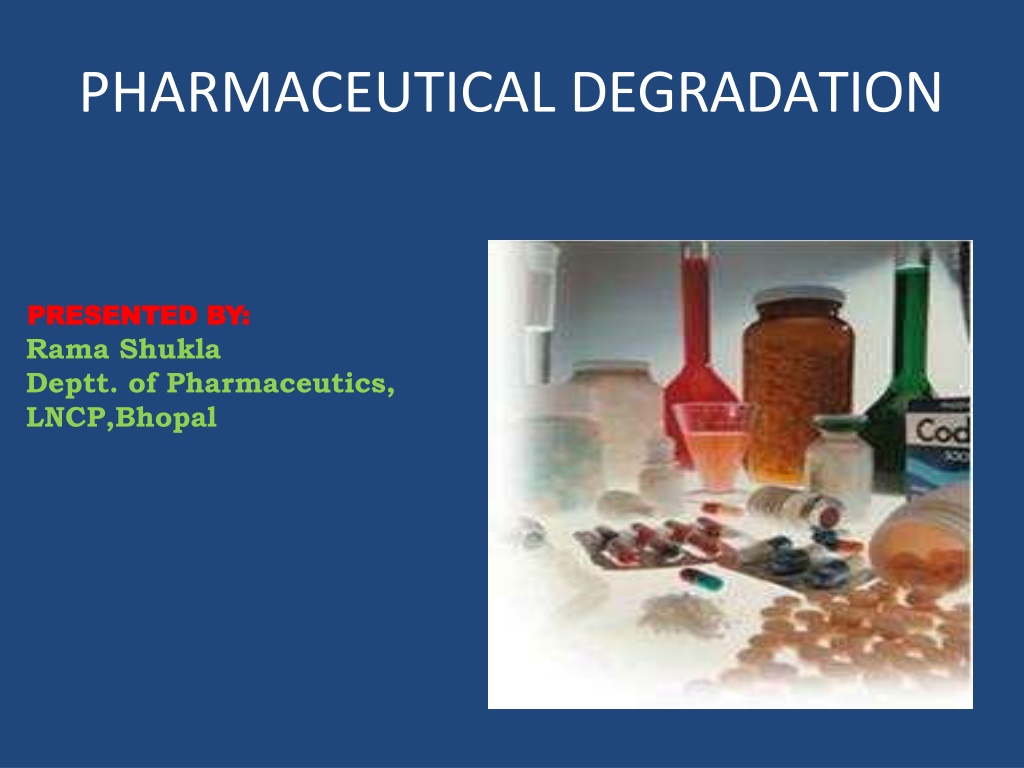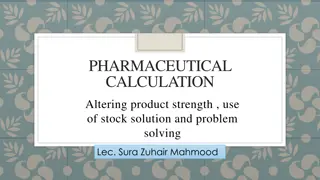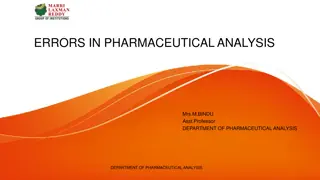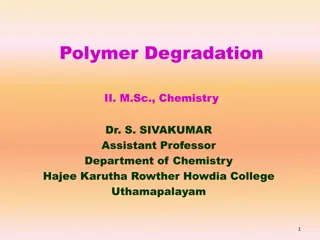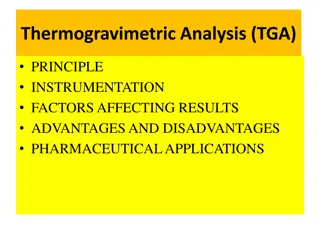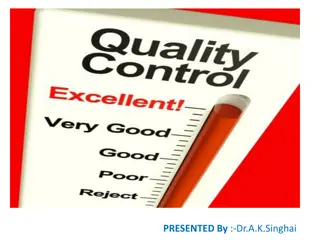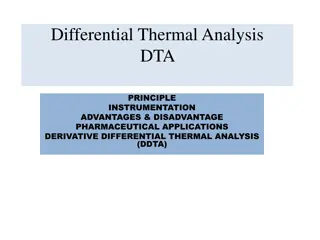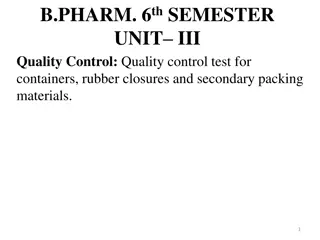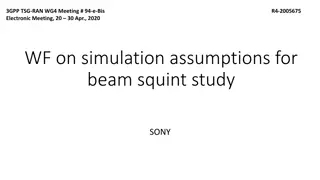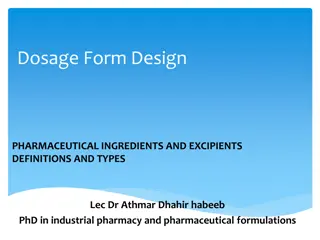Understanding Pharmaceutical Degradation: Types and Factors
Pharmaceutical degradation refers to the process of a formulation in a specific container losing its chemical, microbiological, therapeutic, physical, and toxicological specifications. It can be categorized into physical, chemical, and microbiological degradation. Physical degradation alters the drug's physical nature, such as appearance, organoleptic properties, hardness, and particle size. Factors affecting physical degradation include loss of volatile components, water absorption, crystal growth, polymorphic changes, and color changes. Volatile components like alcohol, ether, and volatile oils can escape from formulations, leading to degradation.
- Pharmaceutical degradation
- Physical degradation
- Chemical degradation
- Microbiological degradation
- Factors affecting degradation
Download Presentation

Please find below an Image/Link to download the presentation.
The content on the website is provided AS IS for your information and personal use only. It may not be sold, licensed, or shared on other websites without obtaining consent from the author. Download presentation by click this link. If you encounter any issues during the download, it is possible that the publisher has removed the file from their server.
E N D
Presentation Transcript
PHARMACEUTICAL DEGRADATION PRESENTED PRESENTED BY: Rama Shukla Deptt. of Pharmaceutics, LNCP,Bhopal BY:
DEGRADATION The condition or process of degrading or being degraded.Decline to a lower quality,condition or level.
PHARMACEUTICAL DEGRADATION The incapacity or incapability of a particular formulation in a specific container to remain within a particular chemical, microbiological, therapeutical, physical & toxicological specification.
ASPIRIN Decompose into acetic acid and salicylicacid giving the acetic acid odour by the break down. The breakdown is a chemical reaction involving the collisions of the molecules.This breakdown is affected by various factors such as presence of oxygen, acidity, alkalinity, moisture and light. This breakdown is what we are calling degradation.
TYPES OF PHARMACEUTICAL DEGRADATION Pharmaceutical degradation is of following type. It can be divided into three major types: 1. Physical degradation 2. Chemical degradation 3. Microbiological degradation
PHYSICAL DEGRADATION It is the degradation which results into the change of physical nature of drug. The formulation is totally changed by way of appearance, organoleptic properties, hardness, brittleness, particle size.
Factors effecting physical degradation are as under: 1. Loss of volatile components 2. Loss of H2O 3. Absorption of H2O 4. Crystal growth 5. Polymorphic changes 6. Colour changes
1) Loss Of Volatile Components: Many drugs and excipients may be lost from pharmaceutical products at ambient temperature through vaporization. These Volatile components such as Alcohol ,ether,Iodine, volatile oils,Camphor menthol etc escape from the formulations rendering them degraded.
EXAMPLE: Aromatic waters Elixirs Some types of tablets which contain aromatic water (Nitroglycerine tablets) PREVENTION: Such product should be placed in well closed container Temperature should be proper.
2) LOSS OF H20: Evaporation of water from liquid preparations will cause concentration of the drug to change with the possibility of crystilization occurring if the solubility of the drug in the solvent is exceeded. Water loss from oil- in water creams may result in a decrease in volume and a surface rubbery feel. Further evaporation of the water will cause the emulsion to crack.
Some drugs are efflorescent, which mean they will lose water to the atmosphere resulting in a concentration of the drug and overall weight loss. Water loss to the atmosphere can be prevented by storing the pharmaceutical product in a well closed container.
EXAMPLES Saturated solution: by loss of water they become supersaturated and precipitate as crystals are formed . Emulsions: Loss of water lead to separation of the two phases and change to other type Creams: especially oil/water, they become dry by loss of water
3) ABSORPTION OF H20(MOISTURE) HYGROSCOPITY Hygroscopic drugs absorb the water from external atmosphere causing the physical degradation. For example, some drugs are delisquent (calcium chloride and potassium citrate), whereas others are hygroscopic (glycerol and dry plant extracts). Effervescent powders and tablets will deteriorate if stored in a moist atmosphere..
EXAMPLE Powders: Liquification and degradation may occur as a result of absorption of water Suppositories which base made from hydrophilic substances as Glycerin, Gelatin, polyethylene glycol. The consistency of these forms becomes jelly-like appearance. Products should be placed in well-closed container and in dry place.
4) POLYMORPHISM Polymorphs are different crystal forms of the same compound .Polymorphs differs from one another in the crystal energies, the more energetic ones converting to the least energetic or most stable one. Different polymorphs of the same drug may exhibit different solubility and melting points.
In polymorphic changes crystal forms are changed. A stable crystal form loosens. This may cause alteration in solubility and possibly crystalline growth in aqueous suspensions. Ex Chloremphenicol Palmitate Cocoa Butter
5) CRYSTALGROWTH Drugs when loose water,become saturated and crystal growth occurs.Molecules in the crystal are not static, they can grow in size and move when there is a medium to travel. Crystallization is enhanced in porous tablets.
EXAMPLE Carbamazepine tablets containingstearic acid form column shaped crystals on tablet surface during storage at high temperature.
6) COLOUR CHANGES Colour changes are of two types. Loss of colour Development of colour 1) Loss of colour is due to PH change 2) Development of colour is due to Exposure to light
EXAMPLE: Phenolphthalein color changes as the Ph changes.It is colorless in acidic solution and pink in basic. PREVENTION: PH should be adjusted Exposure to light should be avoided An attempt has been made to prevent the fading by incorporating UV light absorbing material.
Physical stability (Cont.) Formulation Likely physical instability problems Effects Oral solutions 1- Loss of flavour 2- Change in taste 3- Presence of off flavoursfeel or Change in smell or taste due to interaction with plastic bottle 4- Loss of dye 5- Precipitation 6- discoloration
Physical stability (Cont.) Formulation Likely physical instability problems Effects Suspensions 1 settling 2 caking 3 crystal growth 1-Loss of drug content uniformity in different doses from the bottle 2- loss of elegance.
Physical stability (Cont.) Formulation Likely physical instability problems Effects 1 Creaming 2 coalescence Emulsions 1- Loss of drug content uniformity in different doses from the bottle 2- loss of elegance
Physical stability (Cont.) Coalescence
Physical stability (Cont.) Formulation Likely physical instability problems Change in: a) Disintegration time b) Dissolution profile c) Hardness d) Appearance (soft and ugly or become very hard) Effects Tablets Change in drug release
Physical stability (Cont.) Formulation Likely physical instability problems Change in: a) Appearance b) Dissolution c) Strength Effects Capsules Change in drug release
Physical stability (Cont.) Formulation Likely physical instability problems Effects Semisolids (Ointments and suppositories) 1. Changes in: a) Particle size b) Consistency 1-Loss of drug content uniformity 2- loss of elegance 2. Caking or coalescence 3-change in drug release rate. 3. Bleeding
CHEMICAL DEGRADATION It is the separation of chemical compound into elements or simpler compounds. Change in the chemical nature of the drug is called as chemical degradation.
TYPES OF CHEMICAL DEGRADATION Types of chemical degradation are 1. Hydrolysis 2. Oxidation 3. Decarboxylation 4. Isomerization 5. Polymerization
HYDROLYSIS Splitting by water. Drugs with functional groups such as esters, amides, lactones or lactams may be susceptible to hydrolytic degradation. It is probably the most commonly encountered mode of drug degradation because of the prevalence of such groups in medicinal agents and the ubiquitous nature of water.
Example ASPIRIN: Aspirin degrade into salicylic acid and acetic acid giving vinegar like odour.
OXIDATION Removal of an electropositive atom, radical or electron, or the addition of an electronegative atom or radical. Types: Oxidation has two types Auto-oxidation Photo-oxidation
AUTO-OXIDATION Oxidation in which the oxygen present in the air is involved. This process proceeds slowly underthe influence of atmospheric oxygen e.g. Oil, fats & unsaturated compound can undergo auto- oxidation
PHOTO-OXIDATION Oxidation in which removal of the electron is involved with out presence of O2. This type is less frequently encountered e.g. It occurs in adrenaline, riboflavin & ascorbic acid etc.
DECARBOXYLATION Elimination of CO2 from a compound.Drug substances having a carboxylic acid group are sometimes susceptible to decarboxylation, 4-Aminosalicylic acid is a good example.
ISOMERIZATION It is the process by which one molecule is transformed into another molecule whichhas exactly the same atoms, but the atoms are rearranged e.g. A-B-C B-A-C Conversion of an active drug into a less active or inactive isomer having same structural formulabut different stereochemicalconfiguration
Types of Isomerization: 1) Optical Isomerization 2) Geometrical Isomerization OPTICAL ISOMERIZATION: A change in the optical activity of a drug may result as a change in its biological activity. It is further divided into: (i)RACEMIZATION (ii) EPIMERIZATION
RACEMIZATION: It involves the optically active form of a drug into its enantiomorph. E.X : By the action of heat (-) hyoscyamine is readily converted to atropine which is the racemic mixture of (+) & (-) hyoscyamine.
Epimerization: It occur with the compound having more than one asymetric carbon atom in the molecule. E.X: Under prolonged storage solution containing ergometrine is decomposed by hydrolysis and isomerized to ergometrinine.
GEOMETRICAL ISOMERIZATION: Loss of activity due to the difference in potency exhibited by CIS & TRANS isomers of some organic compounds. EX: Active form of VITAMIN A molecule has all trans configuration.In aqueous solution as a component of multivitamin preparation,in addition tooxidation VITAMIN A PALMITATE isomerizes and form 6-mono cis and 2,6 di-cis isomers,both have lowpotency.
POLYMERIZATION Combination of two or more identical molecules to form a much larger and more complex molecule. e.g. Degradation of antiseptic formulations and aldehydes is due to polymerization. Formaldehyde solution may result into formation of white deposit when stand in cold.
PHOTODEGRADATION Photodegradation is the process by which light- sensitive drugs or excipient molecules are chemically degraded by light, room light or sunlight. PHOTOLYSIS: It is defined as decomposition of a drug by light.
Photodegradation of Primaquine & chloroquine give different products by various pathways. Sodium nitropruside stable for 1 year if protected otherwise may degrade after 4 hours. It can be prevented by : Suitable packing in amber coloured bottles. Cardboard outers Aluminium foil over wraps.
Stabilization of drugs against hydrolysis, oxidation and photolysis: TEMPERATURE: All the drug products are stored at suitable temperatures to avoid thermal acceleration of decomposition. LIGHT: Light sensitive materials are stored in ambered colour bottles
Humidity Packing materials are chosen (usually glass and plastic) to prevent exposure of drug products to high humid condition. Oxygen Proper packing keeping the oxygen content of the solution less and leaving very little head space in the bottle above the drug products are methods to fight against oxidation
MICROBIAL DEGRADATION Contamination of a product may sometimes cause a lot of damage and sometimes may not be anything at all. Thus it is dependent on the type of microbe and its level of toxicity it may produce. If parenterals or opthalmic formulations are contaminated, it may cause serious harm.
Pyrogens which are the metabolic products of bacterial growth are usually lipo polysaccharides and they represent a particularly hazardous product released by gram negative bacteria. If administered inadvertently to a patient they may cause chills and fever.
PREVENTION OF MICROBIAL DEGRADATION suitably designing thecontainers usually using single dosecontainers sticking to proper storageconditions adding an antimicrobial substanceas preservative.
METHOD FOR DETECTING CHEMICAL/ PHYSICAL DEGRADATION THERMAL ANALYSIS: Following methods can be used for detection, DIFFERENTIAL SCANNING CALORIMETRY (DSC) DIFFERENTIAL THERMAL ANALYSIS (DTA) DIFFERENTIAL THERMOGRAVIMETRY (DTG)
